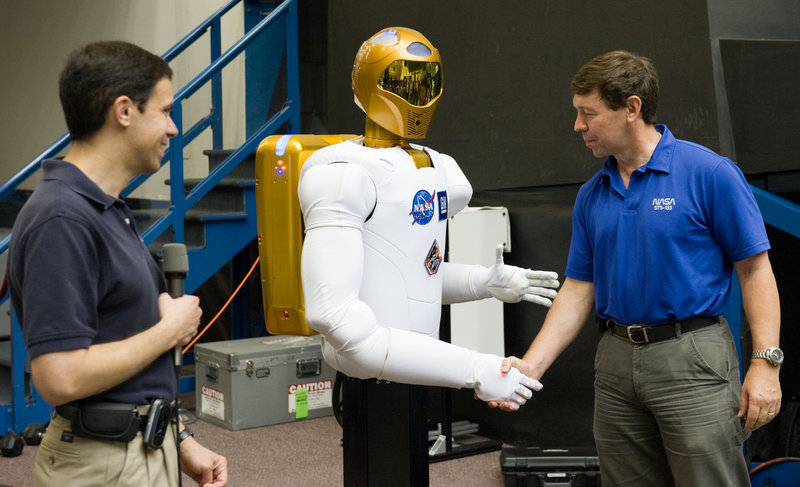CAPE CANAVERAL, Fla — Space is about to get its first humanoid from planet Earth.
Robonaut 2 – affectionately known as R2 – is hitching a one-way ride to the International Space Station this week aboard the final flight of space shuttle Discovery.
It’s the first humanoid robot ever bound for space, a $2.5 million mechanical and electrical marvel that NASA hopes one day will assist flesh-and-bone astronauts in orbit.
Imagine, its creators say, a future where Robonaut could take over space station cleaning duties; spend hours outside in the extreme heat and cold, patiently holding tools for spacewalking astronauts; and handle emergencies such as toxic leaks or fires.
Why, Robonaut’s descendants could even scout out asteroids, Mars and other worlds in the decades ahead, paving the way for humans.
The adventure begins Wednesday afternoon, with the planned final launch of Discovery and Robonaut’s six human crewmates. Mission managers gave the go-ahead Monday for the new launch date; shuttle gas leaks had to be repaired before the countdown could begin and forced a two-day delay.
“While it might be just a single step for this robot, it’s really a giant leap forward for tinmankind,” said Rob Ambrose, acting chief of Johnson Space Center’s automation, robotics and simulation division in Houston.
For now, R2 – a collaboration between NASA and General Motors – exists only from the waist up. It measures 3 feet 4 inches tall and weighs 330 pounds. Each arm is 2 feet 8 inches long.
Legs are still in the works. But, oh, what an upper body: perfectly toned arms and hands with palms, a robotic rarity, along with broad shoulders and a washboard stomach. Arnold Schwarzenegger, Hollywood’s cyborg Terminator, would be proud.
Watch Robonaut lifting a 20-pound dumbbell, and “you can kind of feel the burn,” Ambrose said, showing a video at a recent news conference.
Unlike people who tend to cheat, “this robot will really do what the physical trainers tell you to do, which is to do the bicep curls nice and slow,” he said.
Made of aluminum and nickel-plated carbon fiber, the torso and arms are padded to protect Robonaut and the astronauts, all the way down to the five fingers on each hand. No metal, bony-looking fingers for this robot.
R2’s eyes are where they should be: in its gold-colored head. Four visible light cameras are located behind the robot’s visor, and an infrared camera is in its mouth for depth perception.
But its brain is in its tummy; engineers had nowhere else to put the computerized gray matter. A backpack holds a power system for plugging R2 into the space station. On an asteroid or Mars, the backpack would contain batteries.
The joints are filled with springs for give, and more than 350 electrical sensors are scattered throughout, allowing R2 to sense even a feather with its fingertips.
NASA began working on its first dexterous robot – the landlubbing Robonaut 1 – in 1997. Lacking money, the project ceased in 2006. General Motors stepped in with the intention of improving car manufacturing and better protecting workers. Early this year, the much speedier R2 was unveiled.
NASA made room for the robot on one of its last few shuttle flights. It is Discovery’s 39th mission and the next-to-last shuttle flight for NASA, although an additional trip may be added next year.
R2 is boxed up and stowed away for launch. Its identical twin – identical on the outside, anyway – is at Kennedy Space Center, posing for pictures and awaiting liftoff.
The robot will remain tucked away at the space station until late December – a nice Christmas present for the station’s six inhabitants, Ambrose figures.
Send questions/comments to the editors.



Success. Please wait for the page to reload. If the page does not reload within 5 seconds, please refresh the page.
Enter your email and password to access comments.
Hi, to comment on stories you must . This profile is in addition to your subscription and website login.
Already have a commenting profile? .
Invalid username/password.
Please check your email to confirm and complete your registration.
Only subscribers are eligible to post comments. Please subscribe or login first for digital access. Here’s why.
Use the form below to reset your password. When you've submitted your account email, we will send an email with a reset code.